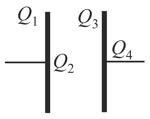In an isolated parallel plate capacitor of capacitance , the four surfaces have charges as shown. The potential difference between the plates is :



Important Questions on Capacitance
Assertion: Increasing the charge on the plates of a capacitor means increasing the capacitance.
Reason: Because
Assertion: The capacitance of a capacitor depends on the shape, size and geometrical placing of the conductors and its medium between them.
Reason: When a charge passes through a battery of emf from the negative terminal to an positive terminal, an amount of work is done by the battery.
Assertion :- A dielectric slab is inserted between the plates of an isolated charged capacitor. The charge on the capacitor will remain the same.
Reason :- Charge on an isolated system is conserved.
Assertion: Two adjacent conductors carrying the same charge can be at different potentials.
Reason: The conductors may have different sizes and hence different capacitances.
Assertion: When charges are shared between two parallel plate capacitors, a charge of the system is conserved, but some energy is lost.
Reason: During the sharing of charges, some energy is dissipated as heat.
Assertion:- On filling the space between the plates of a parallel plate air capacitor with a dielectric, the capacity of the capacitor is increased.
Reason:- The same amount of charge can be stored at a reduced potential.
Assertion: A parallel plate capacitor is connected across a battery through a key. A dielectric slab of dielectric constant is introduced between the plates. The energy which is stored becomes times.
Reason: The potential difference between the plates remains constant or unchanged.
Assertion: When a capacitor is charged by a battery, both the plates receive charges equal in magnitude, no matter whether the sizes of plates are identical or not.
Reason: The charge distribution on the plates of a capacitor is in accordance with the charge conservation principle.
